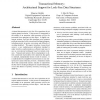Free Online Productivity Tools
i2Speak
i2Symbol
i2OCR
iTex2Img
iWeb2Print
iWeb2Shot
i2Type
iPdf2Split
iPdf2Merge
i2Bopomofo
i2Arabic
i2Style
i2Image
i2PDF
iLatex2Rtf
Sci2ools
ISCA
1993
IEEE
1993
IEEE
Transactional Memory: Architectural Support for Lock-Free Data Structures
A shared data structure is lock-free if its operations do not require mutual exclusion. If one process is interrupted in the middle of an operation, other processes will not be prevented from operating on that object. In highly concurrent systems, lock-free data structures avoid common problems associated with conventional locking techniques, including priority inversion, convoying, and difficulty of avoiding deadlock. This paper introduces transactional memory, a new multiprocessor architecture intended to make lock-free synchronization as efficient (and easy to use) as conventional techniques based on mutual exclusion. Transactional memory allows programmers to define customized read-modify-write operations that apply to multiple, independently-chosen words of memory. It is implemented by straightforward extensions to any multiprocessor cache-coherence protocol. Simulation results show that transactional memory matches or outperforms the best known locking techniques for simple b...
| Added | 08 Aug 2010 |
| Updated | 08 Aug 2010 |
| Type | Conference |
| Year | 1993 |
| Where | ISCA |
| Authors | Maurice Herlihy, J. Eliot B. Moss |
Comments (0)

